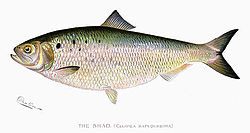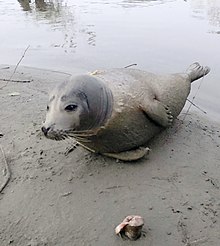American shad
| American shad | |
|---|---|

| |
| Watercolor of an American shad by Sherman F. Denton, 1904: The swelling between the ventral fin identifies this as a gravid female.
| |
| Scientific classification | |
| Domain: | Eukaryota |
| Kingdom: | Animalia |
| Phylum: | Chordata |
| Class: | Actinopterygii |
| Order: | Clupeiformes |
| Family: | Alosidae |
| Genus: | Alosa |
| Species: | A. sapidissima
|
| Binomial name | |
| Alosa sapidissima (A. Wilson, 1811)
| |
| Synonyms | |
|
Clupea sapidissima | |
The American shad (Alosa sapidissima) is a species of
The American shad has been described as "the fish that fed the (American) nation's founders".[4][5] Adult shad weigh between 1.5 and 3.5 kg (3 and 8 lb), and they have a delicate flavor when cooked.[6] It is considered flavorful enough to not require sauces, herbs, or spices. It can be boiled, filleted and fried in butter, or baked. Traditionally, a little vinegar is sprinkled over it on the plate. In the Eastern United States, roe shads (females) are prized because the eggs are considered a delicacy.[7]
The name "shad" derives from the Old English sceadd, meaning "herring"; it is a cognate to Irish, Welsh, and Scottish Gaelic words for herring.[8]
Life history
The shad spends most of its life in the
Like other herrings, the American shad is primarily a plankton feeder, but eats small shrimp and fish eggs. Occasionally they eat small fish, but these are only a minor item in their general diet.[2]
The sexually mature American shad enter coastal rivers in spring or early summer, usually when the river water has warmed to 10 to 13 °C (50 to 55 °F). Cooler water appears to interrupt the spawn. Consequently, the shad run correspondingly later in the year passing from south to north along the coast, commencing in Georgia in January; in March in the waters tributary to Pamlico and Albemarle Sounds; in April in the Potomac; and in May and June in northern streams generally from Delaware to Canada.[2]
In large rivers, such as the Connecticut, American shad run far upstream. The apparent longest distance is in the St. Johns River of Florida, an extremely slow (drops 1 in per mile, 1.5 cm per km) river that widens into large lakes; shad have been found 600 km (375 mi) upriver.[2]
The spawning fish select sandy or pebbly shallows and deposit their eggs primarily between sundown and midnight. Females release eggs in batches of about 30,000 eggs, though an estimated as many as 156,000 eggs are deposited by very large fish. Total annual egg production is 200,000–600,000 eggs per female with larger fish producing more. In rivers north of Cape Fear, the spent fish, now very emaciated, return to the sea immediately after spawning. In southern rivers, most shad die after spawning.
The eggs are transparent, pale pink, or amber, and being semibuoyant and not sticky like those of other herrings, they roll about on the bottom with the current. The eggs hatch in 12 to 15 days at 11 °C (52 °F), in six to eight days at 17 °C (63 °F), which covers the range characteristic of Maine and Bay of Fundy rivers during the season of incubation.
The fry are about 9 to 10 mm (11⁄32 to 13⁄32 in) long. Juvenile shad remain in the rivers until fall, when they move down to salt water; they are now 40 to 115 mm (1+1⁄2 to 4+1⁄2 in) long, resembling their parents in appearance.
Ecology and diet
As adults, shad filter feed at sea and during their return journey to spawn. They are pursued and hunted primarily by

Nutritional information
Like most herring species, American shad are very high in
by EPA estimates. The American or Atlantic shad (A. sapidissima) is a valued food fish.Shad populations

Declines in the
Most of the rivers across the historic range of shad are now heavily dammed, eliminating many of the
Introduced in the North Pacific
American shad were introduced into the
American shad are also occasionally found on the Northwest Pacific coast in
Shad fishing
Shad are also valued as a sport fish that exhibit complex and little-understood feeding behaviors while spawning. Unlike salmon, shad retain the ability to digest and assimilate food during the anadromous migration. Like other fish, their feeding instinct can be triggered by a variety of factors such as turbidity and water temperature.
Society and culture
Shad serve notable symbolic roles in regional politics and culture. On the year of every gubernatorial election, would-be candidates, lobbyists, campaign workers, and reporters gather in the town of Wakefield, Virginia, for Shad Planking. Similarly, in Connecticut, the towns of Essex and Windsor hold annual shad festivals. Each spring, the town of Lambertville, New Jersey, on the Delaware River across from New Hope, Pennsylvania, also hosts an annual Shad Festival. The Salem County New Jersey Attorney Bar Association has held an annual Shad Dinner every Spring since the 1940s. There is a shad museum on the Connecticut River in Haddam, Connecticut.
William Penn negotiated with the Lenape for the shad fishing ground Schuylkill in the 1680s. Shad, he said, were "excellent Pickled or Smoked."[13]
References
- . Retrieved 12 November 2021.
- ^ a b c d e Froese, Rainer; Pauly, Daniel (eds.) (2015). "Alosa sapidissimia" in FishBase. April 2015 version.
- ^ Baltim. Sun. Retrieved 10 May 2015 – via baltimoresun.com.
- ^ Boyle, Robert H. (8 December 2002). "A Sense of Where They Are". The New York Times.
- ^ "Grass Shad-another Fine Bait- Southeastern King Mackerel Club – King Mackerel Fishing in Southeastern North Carolina." Southeastern King Mackerel Club – King Mackerel Fishing in Southeastern North Carolina-. Web. 15 Dec. 2011. <http://southeasternkingmackerelclub.com/grass-shad-another-fine-bait/ Archived 2012-04-26 at the Wayback Machine>.
- ^ a b "American Shad". Fish Reference Library. Nashville, TN, USA: RedOrbit. 3 April 2007. Description. Retrieved 10 May 2015.
- ^ Shad. Oxford English Dictionary. Retrieved 7 November 2017.
- Baltim. Sun. Retrieved 10 May 2015 – via baltimoresun.com.
- ^ New York State Freshwater Fishing 2010–2011 Official Regulations Guide
- ^ "Hudson River Maritime Museum Kingston Shad Festival". Hudson River Maritime Museum. August 2006. Archived from the original on 20 August 2006.
- ^ A. sapidissima (Wilson,1811) - американский шэд Archived 2013-12-03 at the Wayback Machine Позвоночные животные России. sevin.ru
- ISBN 9781903018859.
External links
- Farmer, Fannie Merritt (1901). The Boston Cooking-School Cook Book (3rd ed.). Boston: Little, Brown, and Company. p. 156. Retrieved 4 December 2022 – via Google Books. "Fried Shad Roe" recipe.
- Village Voice article, "Shad Madness".
- New England Shad Association
 Media related to Alosa sapidissima at Wikimedia Commons
Media related to Alosa sapidissima at Wikimedia Commons

